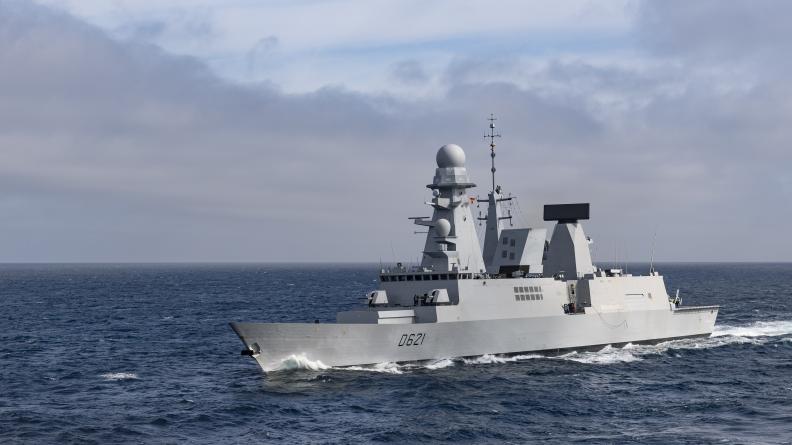Airbus contracted for RIFAN 3
A consortium led by Airbus has been awarded a contract to develop and deploy RIFAN 3, an upgrade to the French Navy’s RIFAN internet protocol communications network between 2026 and 2032, according to a 25th February Airbus press release.
The contract has a maximum value of 480 million euros and a maximum duration of ten years. Work on RIFAN 3 is set to begin in 2026 with developments to begin incrementally between then and 2030. The upgraded network is to be deployed on more than 80 French vessels, including the navy’s aircraft carrier and submarines, between 2028 and 2032.
The aim of the contract is to improve inter-ship connectivity through a new means of high speed and low-latency transmission that will be deployed to frontline ships, according to the press release. This is important for collaborative combat, it adds. Increased cyber resilience will be built into RIFAN 3 as well as general resilience, allowing the network to reconfigure to suit changing scenarios.
“With RIFAN 3, we are preparing for the next stage, that of collaborative naval combat, networked combat of all assets and platforms involved in naval operations,” Eric Even, Head of Space Digital at Airbus Defence and Space said.
RIFAN 2 was deployed to more than 60 French vessels and enabled commanders to exchange both tactical and theatre level information. It is used to coordinate operations as well as manage logistics requirements and day-to-day life on the ships. It included an upgrade to the UHF radios onboard French ships, providing a communication range in the tens of kilometres.
Tech profile: RIFAN 3

A Chevalier Paul is a Horizon-class frigate of the French Marine Nationale, it is designed for air defence and the class has demonstrated collaborative target engagements in the past. Credit: French Navy.
RIFAN 3 will build upon RIFAN 2, which was brought into service by Airbus Defence and Space and its partners between 2012 and 2016. The system brings together a variety of communications mediums including Syracuse IV, Comcept, commercial satellite constellations, and conventional radio transmissions, and allows vessels to communicate using an IP network (internet protocol network). Syracuse IV is the French MoD’s military satellite communications system; it consists of two satellites in geostationary orbit. Comcept is a satellite network that provides the French Navy with IP-based broadband services. Deployed by the French military in 2015, it enhances the Syracuse satellite system by adding bandwidth in the Ka, Ku, and C frequency bands.
An IP network is the infrastructure that allows devices to communicate with each other over the internet or within a local network. When you clicked on the link to read this article, your device would have sent a request to the server hosting it including your IP address, the server would have sent this article back to your device with its own IP address. Each device has its own IP address and when it sends data, that data is broken down into packets that are sent from one device to the other. Once the packets reach the destination device, they are reassembled into the original form. This means that the network is able to decide upon the best possible route for that information. The network is described as very secure and can be used to transmit data with classification levels ranging from ‘unprotected’ to ‘secret’, Airbus states.
Calibre comment
The French Navy, like many others, sees collaborative combat as key to achieving the scale that it needs for future conflicts. In 2019, a Horizon Class vessel, similar to the Chevalier Paul in the image above, remotely engaged a target based on radar data provided by the FREMM frigate Languedoc. This type of collaborative engagement enables a navy to make the best use of its ships by distributing sensors and effectors. However, without robust communications links that can carry data without unnecessary congestion and remain resilient in the face of jamming, this type of capability is difficult to realise. This is why the RIFAN 3 upgrade is an important development for the French Navy, as it offers the potential for improved targeting and defence in the near future.
Beyond collaboration between crewed vessels, collaborative combat can also include uncrewed surface and subsurface vessels, as well as marinized uncrewed aerial platforms can provide a broader distribution of sensors, enabling a fleet to cover a much larger area than it could with crewed vessels alone. However, as the RIFAN 3 contract indicates, this relies on a secure and resilient communications network that also has the bandwidth to pass a lot of data very quickly. The US Navy, for this purpose, is examining the role of proliferated low earth orbit (pLEO) satellite constellations, such as Starshield, the defence equivalent of Starlink. The US Space Force has signed two contracts for pLEO services; a $70 million contract with SpaceX in 2023, and a five year contract valued at up to $900 million with Hughes for access to OneWeb. One final element of this is the management and control of autonomous platforms, which must be considered alongside the secure and reliable communications networks used to deploy them. You can read more about Dominion-X, a land-based solution for deploying autonomous platforms here.
By Sam Cranny-Evans, published on 26th February 2025.

Sign Up for Updates!
Get insider news, tips, and updates. No spam, just the good stuff!





